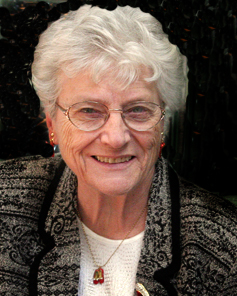
The following article is part of the Diamond Club Member group that began in the January 7, 1943, issue of the Rock County Star Herald. Members of this group consist of persons of age 75 and older.
The following appeared in The Rock County Herald on May 13, 1943, and is continued from last week’s issue.
The Biblical prophecy “there shall be wars and rumors of wars,” may be just another scripture passage to many, but to Mrs. Sarah Scott, Luverne, it has a deep meaning, for during her 82 years of life, she has lived through three years, has seen the beginning of the fourth, and “the end is not yet.”
Mrs. Scott was born May 9, 1861, near Jacksonville, in Cass county, Ill, the daughter of William and Jane Lindsey Matthews. Her father died when she was an infant, and she and her mother and sister lived with her grandmother until her mother was remarried to a man who fought in the Union army during the Civil War.
From her stepfather and from her uncles, Mrs. Scott heard many stories of the Civil War. She had two uncles who were captured by the southern army, and were placed in the famous Andersonville prison. One of them was released before the other and when he left, the one who remained warned him to not eat too much meat after he was released. He had been starved too long, however, and was so famished that he did not overeat after arriving home, and died three days later.
When her stepfather arrived home after the peace had been signed, she remembers she met him with a pair of stockings which she had knit for him with her mother’s help. She was then only about five years old.
Because she had heard so much about the Civil War and the South, the book, “Gone with the Wind” was to Mrs. Scott in the nature of a trip “back home.” She read the book through once, and read half of it the second time, in addition to seeing the movie, she states.
Cass county, where she was born, was a wooded country, and as a girl, Mrs. Scott learned to recognize birds and flowers that were native to that area. “Whenever I wasn’t to be found at home, my folks usually knew that I’d be wandering around amongst the trees,” Mrs. Scott states.
At the age of 14, she began earning her own living, doing housework at $1.25 per week. At the age of 16, she had one of the greatest thrills as a girl when she visited the state house at Springfield, Ill., and saw Lincoln’s tomb.
From Cass county, she moved with the family to McLean county where she lived until going to Ford county. It was there that she met her future husband, Amos Scott, and was married to him at Matamola, Ill., on Jan. 8, 1880. Shortly afterward, they decided to go to Kansas, but got as far as Sedalia, Mo., with their team and buggy, and decided to stay there. After about a year, they returned to McLean county, Ill., by covered wagon, and remained there until 1883 when they decided to come west to Minnesota.
They settled in the southwestern part of the county near the “old iron post” which is the dividing marker between Iowa, South Dakota and Minnesota, and they lived there about eight years.
During that period, Mrs. Scott experienced the famous blizzard of 1888. Her husband had gone to a neighbor’s farm, and she was left alone with a man who had been making his home with them. The day dawned mild and clear, and the temperature was warm until the storm struck about 4 p.m. Mrs. Scott had no fuel or water in the house when the storm struck, but the man who was with her obtained some and managed to get to the barn and get the livestock indoors and safe.
Meanwhile, her husband had started home and found his way to the house after he had come to a clothesline which crossed the lane that led into the farm yard. He followed the wire which led directly to the house, then opened the door and fell virtually exhausted on the floor.
(Story continues next week.)




